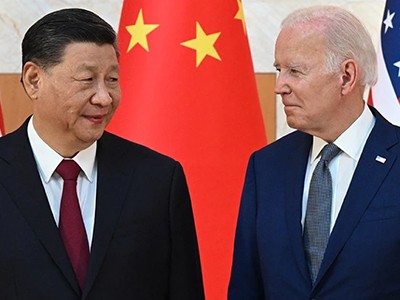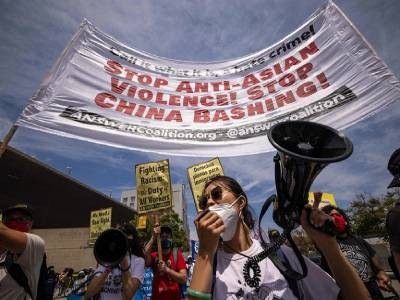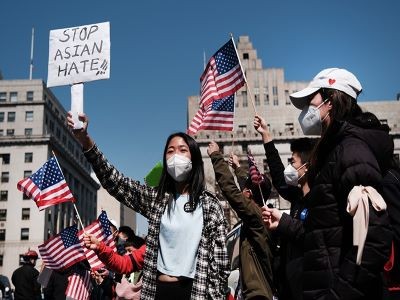US President Joe Biden (left) and China’s President Xi Jinping at an economic cooperation summit in California last year.Credit: Brendan Smialowski/AFP/Getty
China and the United States will once again probably delay the renewal of a decades-old pact to cooperate on science and technology. The two nations have been negotiating for the past six months, but need more time to settle new terms and conditions requested by both sides, sources tell Nature.
The 45-year-old pact is a symbolic agreement that doesn’t provide any funding, but instead lays the groundwork for cooperation on research in a broad range of fields, including health, the environment and energy. Many researchers in the United States and China say that the agreement is crucial to establishing scientific collaborations and building strong research relationships between the two nations. They worry that science will suffer in both countries if the pact is not renewed.
“Collaboration is the only way to conquer a lot of the scientific challenges the world is facing today,” says Marina Zhang, who studies innovation with a focus on China at the University of Technology Sydney in Australia.
Tensions grow
The pact, which is usually renewed every five years, was due to expire on 27 August last year. Rather than fully renew it, the United States and China approved a six-month extension of the current agreement until 27 February, to give officials time to renegotiate. Now, it looks like they will delay it again, and approve a second extension, says Denis Simon, a specialist on US–China innovation and trade relations at the Institute for China–America Studies in Washington DC.

US extends science pact with China: what it means for research
In a statement to Nature, a US State Department spokesperson wrote, “We are not able to provide information at this time on specific U.S. negotiating positions or on whether the agreement will be extended past its current expiration date.” But the spokesperson added that the safety and security of US citizens overseas is the department’s highest priority.
That they are negotiating new terms and conditions reflects changes in the countries’ economic and political priorities since the pact was first signed in 1979. Over the past 45 years, China has developed a stronger global scientific presence, and is now on a more equal footing with the United States than before, Simon says. Also, tensions between the two nations have grown in recent years.
For example, a US programme aimed at safeguarding US laboratories and businesses from espionage targeted researchers of Chinese descent, leading to arrests and controversial trials. The China Initiative, as it was called, was shuttered in 2022, after the US government acknowledged that it was perceived as racially biased. Last year, some lawmakers on a US House of Representatives committee even called on US secretary of state Antony Blinken to scrap the US–China pact on science and technology altogether, alleging that it poses a threat to national security.
New terms
Still, over the past six months, US and Chinese negotiators have met several times to hash out a new pact — a positive sign, says Simon, who is familiar with but not directly involved in the discussions. The United States wants assurances of the personal safety of its scientists who travel to China for collaborative projects, he says. The US State Department is concerned that travellers to mainland China will be subject to the “arbitrary enforcement of local laws” and “wrongful detention”, and has urged travellers to reconsider trips to China for these reasons.

China Initiative’s shadow looms large for US scientists
The United States also wants greater clarity over the access, ownership and sharing of data, Simon says. In 2021, the Chinese government began restricting the flow of academic and health data from China, citing cybersecurity and data-privacy concerns.
So, US negotiators don’t want their scientists “to be told they can’t leave the country with their notebooks because they contain restricted data”, Simon adds.
Deborah Seligsohn, a specialist in US–China relations at Villanova University in Pennsylvania, agrees that the data-sharing rules “create encumbrances”, which is why the United States would like the pact to contain clarification on the matter.
China also has some reservations about renewing the pact as it currently stands, says Zhang, who is similarly familiar with the discussions, although not directly involved. The government wants the agreement to go through, but wants to negotiate better terms for itself, given its stronger global position compared with when the pact was first signed, Zhang adds. It is also concerned that the agreement might encourage Chinese scientists to leave and work in the United States. Academic and industry jobs in science are harder to come by in China because of its slowing economy in recent years, she says.
“China wishes to renew the pact on its own terms,” she adds. “The government realizes if we let these people go, they will make contributions to the United States, not to China.” So, she thinks that China will probably push for terms in the pact that ensure that the United States doesn’t actively poach its scientists.
A narrower partnership?
Observers say that the United States might also want to restrict the fields of research covered by the pact to climate change, global health, food security and clean energy. It is not yet clear how this could affect other areas such as materials science and computing. Previously, the agreement had no restrictions on the types of research that were available for partnership, says Seligsohn.

Scientists’ fears of racial bias surge amid US crackdown on China ties
Researchers slam this idea. Steven Kivelson, a theoretical physicist studying quantum materials at Stanford University in California, says that ending collaboration with China in quantum materials would be like “cutting off our own arms”, because all of the most interesting materials and results in quantum computing are coming from China. Kivelson and his colleague, physicist Peter Michelson, also at Stanford University, wrote to US President Joe Biden last year urging the government to renew the pact. More than 1,000 academics signed the letter.
Both nations — world leaders in science — know that their future scientific success depends on having a relationship, Seligsohn says. “Cooperation is critical to science in both countries,” she says.